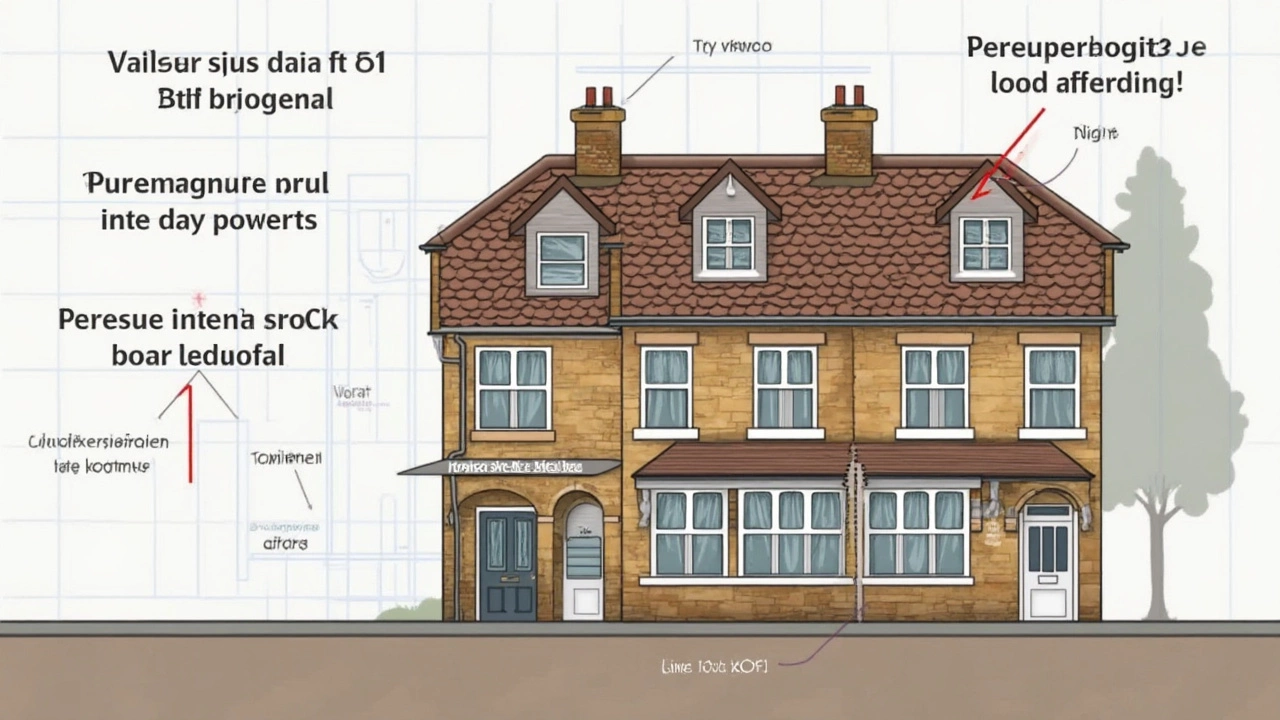A cracked wall might seem like no big deal, but sometimes these little signs scream much bigger problems under the surface. In the world of new builds, a "major structural defect" isn’t just builder talk—it’s the kind of issue that can turn your dream home into a money pit. We're not talking about scuffed paint or squeaky doors. Think about the essential bones of the house—foundation, load-bearing walls, and the roof. When these parts fail, the stability and safety of your home are at risk.
Even brand-new homes aren’t immune. Sometimes, shortcuts in materials or rushed construction mean you end up with big headaches before you’ve even unpacked your boxes. Warranties help, but getting them to cover major repairs often depends on knowing exactly what kind of defect you’re dealing with. It gets tricky because not every crack or minor sag counts as a 'major' structural problem—but if it makes your home unsafe, or stops it from functioning as intended, you’ve got a serious issue on your hands.
- What Makes a Defect ‘Major’?
- The Most Common Major Structural Defects
- Early Warning Signs You Shouldn’t Ignore
- What To Do if You Find a Major Defect
What Makes a Defect ‘Major’?
When you hear someone talk about a major structural defect, they mean a problem that hits the heart of what holds your house together. It's not about small surface cracks or loose tiles. It's stuff that messes with the foundation, load-bearing walls, floors, beams, or the roof—basically, anything that keeps the place from falling apart. These aren't just annoying; they can make your home straight-up unsafe or unlivable.
If you want to get really clear, a defect gets called “major” when it:
- Seriously affects the safety or stability of your home.
- Makes the house partially or totally unfit to live in.
- Will be expensive or tough to fix without some serious work.
- Keeps the house from being used as it was meant to—like when a tilted floor makes a whole room useless.
With new builds, building codes in places like Australia, the UK, and the US usually set a strict bar for what counts as a structural issue. For example, if the foundation sinks, big cracks open up in the walls, or roofs start sagging badly in the first few years, you're likely dealing with a major defect—the kind that’s covered under most structural warranties.
Here’s a quick table showing the difference between minor and major defects:
| Defect Type | Minor Defect (Not Structural) | Major Structural Defect |
|---|---|---|
| Cracks in walls | Hairline cracks in plaster | Wide cracks affecting bricks or load-bearing walls |
| Doors/windows | Sticky door from swelling | Frame shifts due to foundation movement |
| Floors | Squeaky or uneven floorboards | Serious sagging or buckling of floor structure |
One last important thing—if you spot any issue that makes your home less safe or look like it might get a lot worse fast, treat it seriously. Don't assume it's just cosmetic. It could be a sign of something big brewing underneath.
The Most Common Major Structural Defects
If you’re checking out a new build, it’s not just about how fresh the coat of paint looks—serious problems can be hiding behind the scenes. Major structural defects in houses usually hit the foundation, walls, or roof (no big surprise, since these hold the place up). Let’s break down what can go wrong:
- Foundation Problems: Big, uneven cracks in slab or footings, doors that stick, or floors that slope can all mean the foundation isn’t doing its job. Sometimes it’s poor soil prep, other times it’s rushed concrete work. In one survey, about 25% of new home defects involved foundation issues.
- Sagging Or Collapsed Roofs: This is more than just a leaky shingle. If rafters, trusses, or beams weren’t built right, the roof can start to dip or even break apart. You might see ripples, hear creaks, or spot daylight where there shouldn’t be any.
- Load-Bearing Wall Failures: Knock on the wall and if it shakes or you notice big, diagonal cracks, you could have a load-bearing wall failure. Sometimes, contractors put in the wrong-sized beams or mess up support posts. That’s the kind of slipup that can make a part of your house literally buckle.
- Significant Water Penetration & Drainage Issues: Water should never be trickling into your home. Poor waterproofing or busted drainage means moisture eats away at foundations and load-bearing walls, leading to real structural headaches.
- Major Floor Movement: Floors that bounce, dip, or separate out from the wall point to deeper faults—sometimes a botched frame, sometimes bad joists, or even termite damage in unlucky areas.
Here’s a quick look at how often these big defects pop up in new builds, based on recent builder warranty data:
| Structural Defect Type | New Builds Affected (%) |
|---|---|
| Foundation Cracks/Movement | 25% |
| Roof Structural Issues | 15% |
| Waterproofing Failures | 20% |
| Load-Bearing Wall Failures | 10% |
| Floor Structure Movement | 8% |
Spot any of these in a new build, and you’re probably looking at a major structural defect. These aren’t issues you can just patch up with filler or slap more drywall over—getting to the root of the problem is what keeps your home standing strong and safe.

Early Warning Signs You Shouldn’t Ignore
When it comes to major structural defect issues in new builds, the biggest problems usually start small. You want to catch these before they spiral into wallet-draining disasters. So, what should you be watching out for?
- Cracks wider than 5mm: Not every crack means trouble, but if you see thick, diagonal cracks—especially above doors or windows—take them seriously. This might mean your house is shifting because of a faulty foundation.
- Doors and windows sticking or not closing: If previously smooth doors now jam or windows have trouble closing, that’s often due to movement in the structure, not just paint swelling.
- Sagging or uneven floors: Walk around with your phone in video mode and point it at the floor—slopes show up fast. Major dips might mean joist failure or foundation problems.
- Visible gaps between walls, ceilings, or floors: Those little spaces aren’t just ugly. They may signal serious movement in the building’s frame.
- Persistent damp patches or mold in odd places: If you see moisture creeping up walls or pooling indoors, the structure could be shifting and letting water in. This messes with both the building’s guts and your health.
- Roof sagging: Step outside and look at the roofline. Dips or waves aren’t just a bad look—they can mean walls are bowing outward or roof trusses failed.
- Brickwork separates: Bricks pulling away from mortar or shifting apart from each other is a billboard for structural issues, often related to a poor foundation or movement.
Check out this quick table for a snapshot of the most common warning signs and what they often mean:
| Warning Sign | Possible Cause |
|---|---|
| Wide, diagonal cracks | Foundation movement |
| Sagging floors | Joist or foundation failure |
| Sticking doors/windows | Settlement or movement |
| Gaps in structure | Frame shift |
If you spot any of these signs in your new build, don’t shrug it off or assume it’s just part of the “settling” process. Document everything with photos and videos, then contact your builder or warranty provider right away. Early action can be the difference between a quick fix and a major home repair nightmare.
What To Do if You Find a Major Defect
So, you spot something off—a big crack in the wall, uneven floors, maybe doors that won’t close right. Now what? Don’t just brush it off. Major structural defect problems are the sort you can't ignore or DIY your way out of. Your next steps matter, not just for peace of mind, but for your wallet and safety, too.
The first thing to do is get a reputable structural engineer or building inspector to check it out. You want someone who isn’t tied to the builder or developer. These experts can figure out if the problem really is a major structural defect or something less serious. Pay attention to their report—they’ll flag if there’s a threat to the structure, serious water damage, or foundation shifts. Always ask for a written report with photos. This is your golden ticket if you need to deal with insurance or the builder’s warranty.
If the house is a new build, you’re probably covered by a structural warranty. In the UK, for example, most new homes have a 10-year NHBC Buildmark warranty. This covers structural issues starting in years three through ten, so you’re not out of luck if problems show up later. In Australia, builders have to provide a 6-to-10-year statutory warranty on major defects. Always check your paperwork; details can vary depending on the builder and your location.
Here’s what to do if you find a major structural defect in your new home:
- Take clear photos or videos as soon as you notice the issue. Document any changes over time.
- Gather your purchase and warranty documents. Look for what is covered and any time limits for making claims.
- Get an independent inspection. Attach their full report to your case for proof.
- Notify your builder in writing—email is fine, but always keep copies. Describe the problem, include photos, and attach your inspection report.
- If the builder doesn’t respond or refuses to fix it, contact your warranty provider or local regulatory body. In the UK, that’s often the NHBC; in Australia, the relevant state building authority. Many buyers don't realize you can also go to consumer tribunals if the builder drags their feet.
If you’re in a spot where you have to fix things urgently—say, a roof collapse or major water ingress—get quotes in writing and keep receipts. Sometimes you can recover those costs through your warranty if you follow their process and notify them first if possible.
Just to give you an idea, here’s a quick snapshot of how long major warranties last for new builds in different countries:
| Country | Typical Structural Warranty Length |
|---|---|
| UK | 10 years (NHBC, LABC, Premier Guarantee) |
| USA | 10 years (varies by state and provider) |
| Australia | 6-7 years (statutory, varies by state) |
The real key? Don’t let the issue drag on. The sooner you act, the better your odds of getting the major structural defect sorted without massive out-of-pocket costs.





